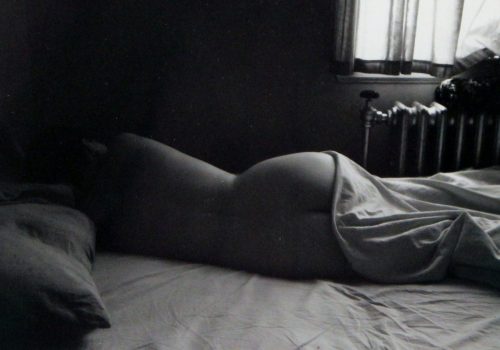Robert Mann Gallery presents a selection of Harry Callahan’s most iconic works from a recently acquired collection. Harry Callahan was a hobbyist photographer turned professional artist who left a lasting mark on the discipline. His experiments with line and form, light and dark, expanded the boundaries of those who came before him by reconciling the pictorial and structural photographic traditions of the earlier twentieth century.
The photographs in the exhibition express the constant formal and conceptual concerns that give unity to Harry Callahan’s treatment of some of his favorite subjects. The intimate landscape, including views of fields, leaves, and weeds of Aix-en- Provence, the sandy beaches of Cape Cod and the snowy shores of Lake Michigan in Chicago (trees in snow), c. 1950, exemplify Callahan’s reduction of photography’s unbroken scale of tones to the extreme whites, the pure blacks, and a middle gray in scenes with details that are delicate and inexhaustibly intricate. The studies of his beloved wife Eleanor reveal her as an individual, an icon, and a symbol of all woman — no matter how small a part of the scene, Eleanor dominates the viewer’s eye. Callahan’s technical experimentation in thematic synthesis, including multiple exposures, is represented by a pristine example of Detroit, 1943, one of three known multiple-exposure images of Detroit streets that Callahan created in 1943 with his 9 x 12 cm Linhof camera. The image is tied to reality yet freed from traditional representational qualities that challenges perceptions.
John Szarkowski, the visionary director of photography at MoMA, wrote, “In spite of the fact that Callahan has worked with a wide range of techniques and equipment, and has pursued his favorite motifs in several countries, his work is informed by a rare integrity, a coherence created by the intensity and logic of his search for pictorial clarity.” Callahan’s photographs are highly organized with clean, graceful lines that introduced a vocabulary of formal abstraction into American photography through daring compositions with extreme contrast, reduction of form and prolonged shutter speeds. His prints often use limited tone and intense contrast to emphasis linear qualities. Keith Davis, the Senior Curator of Photography at the Nelson- Atkins Museum of Art, described Callahan’s work as that which “balances description and abstraction, personal expression and universal meaning, the simple and the sublime…faithful to subject matter while being clearly about formal structures of photographic picture making.”
Harry Callahan (1912-1999) was born in Detroit, Michigan. He began photographing in 1938 and was entirely self-taught. He photographed extensively throughout his career, but produced only around one dozen final images each year. In 1946, László Moholy-Nagy and Arthur Siegal invited him to teach photography at the Institute of Design in Chicago where he was head of the photography department from 1949 to 1961. From 1961 to 1973, Callahan taught at the Rhode Island School of Design, where his dedication to teaching enriched a visual lineage of prominent photographers, including Ed Sievers, who later become a mentor and friend to Mike Mandel, both of whom are represented by the gallery. In 1978, he became the first photographer to represent the United States at the Venice Biennale. The Museum of Modern Art in New York City presented a major retrospective of his work in 1976. He won many awards including ICP’s Master of Photography Infinity Award in 1991. Callahan died in Atlanta, Georgia in 1999.
Harry Callahan: From a Recently Acquired Collection
September 12 – October 19, 2019
Robert Mann Gallery
525 West 26thStreet
New York NY 10001
















